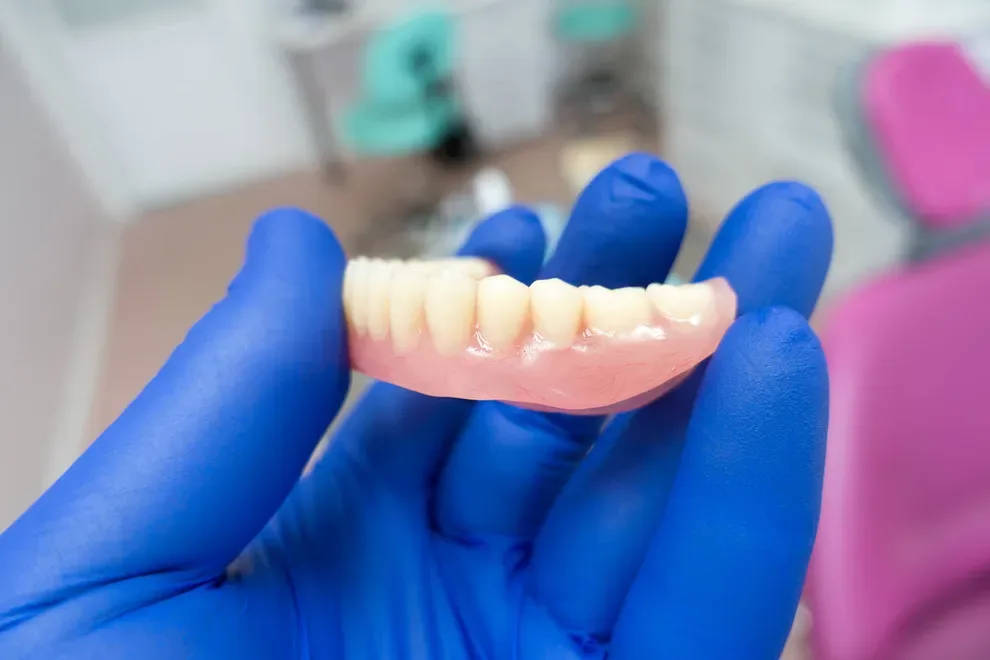What Are Partial Dentures? Types, Costs & Uses

Table of Contents
- What are Partial Dentures?
- Full vs. Partial Dentures
- Types
- How to Decide What Type?
- Costs
- How to Care for Your Dentures
Missing teeth can be replaced with implants, dental bridges, or dentures. Dentures are a removable solution to missing teeth. Partial dentures are used to replace a few teeth in either your upper or lower jaw, as opposed to full dentures that are meant to replace all of your teeth.
There are a few options when it comes to partial dentures. The primary options are metal, plastic, or acrylic dentures.
The cost for partial dentures is going to depend on several factors, including the type you decide on, the number of teeth you are replacing, and their location. It is recommended to use denture cleaner to clean your dentures and stick to a care plan outlined by your dentist.
Missing teeth is a common issue, especially as we age. Nearly a third of all Americans between the ages of 65 and 74 have none of their natural teeth left.1
Partial Dentures Explained
Dentures are removable replacement teeth. You can lose teeth for a variety of reasons, such as these:
Tooth decay
Injury
Illness
Tooth extraction or removal
Trauma
Lost teeth will need to be replaced. If you are only missing a few teeth, your dentist may recommend partial dentures. These are removable dental prosthetics that can fill the gaps in your mouth.
Partial dentures usually have a plastic or metal framework that holds however many teeth need to be replaced.2
Partial dentures can replace missing teeth on both sides of your mouth at the same time. These dentures are then clasped or attached to your teeth with precision attachments. Partial dentures are removable, unlike dental bridges, which are fixed and cemented into place.
Full vs. Partial Dentures
Full, or complete, dentures replace an entire set of your teeth, while partial dentures are used to replace a few missing teeth on either the top or bottom of your mouth.3
If you have no teeth left, you will need full dentures. If you still have some natural and healthy teeth left, partial dentures can be a better option.
Partial dentures can help to preserve the rest of your teeth while filling out your mouth and smile. Partial dentures also cost less than a set of full dentures.
Types of Partial Dentures
There are three main types of partial dentures: cast metal dentures, acrylic flippers, and flexible dentures. Partial dentures are secured onto your teeth in a few different ways.
Partial dentures can be either posterior (located in the back of your mouth) or anterior (replacing teeth in the front of your mouth). They are made from a variety of materials, including metals, plastics, and composite products.
We’ve outlined the primary types of partial dentures and clasps:
Cast metal partial dentures: These partial dentures have a metal base that is most often made up of a cobalt and chromium alloy. When used in partial dentures, this fares better than titanium alone. These partial dentures are among the most common. They are lightweight, durable, stable, and can look the most natural. This denture type will use false teeth and a gum-colored acrylic base that can be good for long-term use.
Acrylic flippers: These are generally considered to be a temporary option, as they are not as durable. Made from an acrylic base and using plastic teeth, acrylic flippers are generally the least expensive type of denture and meant to be used on a short-term basis.
Flexible partial dentures: Flexible partial dentures are some of the most aesthetically appealing partial dentures. They are made from a flexible plastic material. These partial dentures can better match your natural teeth and gums. However, they are not as durable and strong as cast metal partial dentures.
Metal clasps: Partial dentures will need a way to attach to your existing teeth. Often, this is done by using metal clasps. These clasps will circle the teeth adjoining the gap where the dentures are going to fit. Depending on where in your mouth the dentures are being placed, metal clasps can be visible.
Precision attachments: Precision attachments are custom-made and more aesthetically pleasing than metal clasps, allowing your partial dentures to attach to your natural teeth without showing when you smile.4 These are going to cost more and take more time to form than metal clasps. Attachments for partial dentures will also often require a crown on your natural tooth in order to fit properly.
Deciding on a Type of Partial Denture
Considerations when deciding on the type of partial dentures to get should include the following:
Dentist recommendations
Cost
Durability
Location in your mouth
Overall aesthetics
Your dentist can work with you to decide which are the best options for your mouth. Often, metal-based, plastic dentures can offer you the most support, durability, and stability.
Costs for Partial Dentures
Partial dentures are going to range in cost depending on several factors, such as these:
Type of partial dentures
Location in your mouth
Attachment type you choose
The dentist placing the dentures
Partial dentures can range in cost from $650 to $2,500 for either the top or bottom teeth (not both). Flexible partial dentures run between $900 and $2,000, and acrylic flippers are the least expensive, ranging from around $300 to $500 each. Dental insurance can help to cover some of the costs of partial dentures.
How to Take Care of Your Dentures
It is important to follow your dentist’s instructions when it comes to caring for your partial dentures. This can help to limit staining and improve their lifespan.
You will need to use a special denture cleaner to clean your dentures, not regular toothpaste. Brush your dentures daily to remove food particles and keep them from staining. Use a soft-bristled toothbrush or a special denture cleaning brush that will not be too harsh or abrasive on the surface of the dentures.
Dentures are not generally designed to be worn around the clock. Dentists will typically recommend that you take them out at night for sleep.
You will need to keep them moist when they are not in your mouth, so the partial denture will retain its shape. You can place them in a special soaking solution or water.
You may need to have your dentures adjusted over time. Keep up with regular dental visits to have your dentures checked on a schedule.
